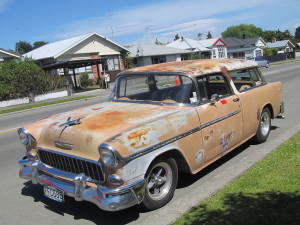Safety Strategies for Classic Car Restoration
By joe89g45ne

By Riley from Christchurch, New Zealand (1955 Chevrolet Nomad) [CC BY 2.0 (http://creativecommons.org/licenses/by/2.0)], via Wikimedia Commons
Form Follows Function
This old adage is popular among architects, but it applies perfectly to cars, as well. Looks may have been the deciding factor when you bought your car – but that doesn’t mean you can throw functionality to the wind. A perfect body and a gleaming paint job don’t count for much if your car sputters and dies on the road. Rust removal, engine repairs, and structural integrity should always be your main concerns.
Welding Dangers
Don’t take any risks when you’re welding. To protect yourself from sparks and molten beads, wear a welder’s mask and some sort of fire retardant material. Also, remove anything remotely flammable from your workspace. Bits of paper and plastic can easily catch fire. Finally, make sure you have a fire extinguisher on hand in case of emergency.
Spotting Asbestos
Asbestos is an extremely heat-resistant material that’s long been used in buildings and automobiles. However, it is also highly toxic and has caused tens of thousands of people to die from cancer. Asbestos was banned in 2003, but many older cars still contain it. It’s commonly found in brake linings, clutches, gaskets, and other parts that are exposed to high temperatures. To avoid inhalation, always wear a safety mask when you’re working with these components.
Avoiding Fumes
You’ll encounter a number of dangerous fumes as you work on your classic car. The most harmful chemical is carbon monoxide – an invisible, odorless gas which can kill within minutes. Newer cars have lower emissions, but old engines are still dangerous. If you work in your garage, leave the door open to allow it to vent.
Fiberglass repairs can also involve noxious chemicals. Most repair kits contain a resin which irritates the skin and eyes. It emits vapors which can cause liver damage, kidney problems, and even cancer. An easy way to avoid these risks is to wear a respirator, which you can find at most hardware stores.
Complete Rust Removal
Rust isn’t just unsightly; it’s extremely dangerous. Oxidized patches on the surface of your car may be harmless, but damage to your chassis, engine block, or floor can create serious problems. Because rust is so brittle, it can easily fall apart while you’re driving or setting new parts. It can also create holes in your interior which allow carbon monoxide and other fumes to seep into the cabin. For your safety – and for your car’s longevity – rust removal needs to be your top priority when you begin your restoration.
Finding Good Help
Ultimately, some repairs are going to be too difficult to tackle yourself. Even if you know what you’re doing, most restoration projects require specialized equipment and industry experience. To get help from the top mechanics in classic car restoration, call a professional now. Don’t settle for anything for anything but the best.
